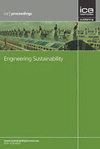Urban microclimate analysis: residential block morphology impact on outdoor thermal comfort
IF 1.5
4区 工程技术
Q3 ENGINEERING, CIVIL
Proceedings of the Institution of Civil Engineers-Engineering Sustainability
Pub Date : 2024-02-07
DOI:10.1680/jensu.22.00042
引用次数: 0
Abstract
In many cities, protracted exposure of urban structures to excessive solar radiation and the urban heat island (UHI) phenomenon may cause thermal discomfort for pedestrians in outdoor spaces, particularly in hot-arid regions. This study investigated the impact of urban residential block morphology on microclimate in Isfahan, Iran, using ENVI-met numerical models. The predicted mean vote (PMV) model for residential outdoor spaces was calculated using simulation data for the hottest day of the summer to assess outdoor thermal comfort. Comparison of the alternatives – namely, diagonal blocks, compact linear blocks, continuous curved blocks and dispersed cubic blocks – showed that the microclimate performance of the diagonal type was better than those of the other design options, as the PMV index represented the minimum distance from the ideal thermal comfort range due to a lower sky view factor (SVF) and optimal orientation. The curved blocks performed better in urban open spaces, promoting airflow and reducing UHI, than linear and cubic blocks. The results showed that the PMV index could predict thermal comfort in various urban design patterns and could be affected by the morphology of urban blocks. Variations in building morphology alter the SVF and microclimate parameters, which have an impact on outdoor thermal comfort.城市微气候分析:住宅区形态对室外热舒适度的影响
在许多城市,城市结构长期暴露在过量的太阳辐射和城市热岛(UHI)现象下,可能会给室外空间的行人带来热不适,尤其是在炎热干旱地区。本研究利用 ENVI-met 数值模型研究了伊朗伊斯法罕城市住宅区形态对微气候的影响。利用夏季最热一天的模拟数据计算了住宅室外空间的预测平均投票(PMV)模型,以评估室外热舒适度。对对角线砌块、紧凑线性砌块、连续曲线砌块和分散立方体砌块等备选方案进行比较后发现,对角线砌块的微气候性能优于其他设计方案,因为 PMV 指数代表了由于较低的天空视线系数(SVF)和最佳朝向而与理想热舒适范围之间的最小距离。与直线型和立方型砌块相比,弧形砌块在城市开放空间中的表现更好,可以促进空气流通,减少 UHI。结果表明,PMV 指数可以预测各种城市设计模式下的热舒适度,并可能受到城市街区形态的影响。建筑形态的变化会改变 SVF 和微气候参数,从而对室外热舒适度产生影响。
本文章由计算机程序翻译,如有差异,请以英文原文为准。
求助全文
约1分钟内获得全文
求助全文
来源期刊

Proceedings of the Institution of Civil Engineers-Engineering Sustainability
ENGINEERING, CIVIL-ENGINEERING, CIVIL
CiteScore
3.70
自引率
16.70%
发文量
44
审稿时长
>12 weeks
期刊介绍:
Engineering Sustainability provides a forum for sharing the latest thinking from research and practice, and increasingly is presenting the ''how to'' of engineering a resilient future. The journal features refereed papers and shorter articles relating to the pursuit and implementation of sustainability principles through engineering planning, design and application. The tensions between and integration of social, economic and environmental considerations within such schemes are of particular relevance. Methodologies for assessing sustainability, policy issues, education and corporate responsibility will also be included. The aims will be met primarily by providing papers and briefing notes (including case histories and best practice guidance) of use to decision-makers, practitioners, researchers and students.
 求助内容:
求助内容: 应助结果提醒方式:
应助结果提醒方式:


